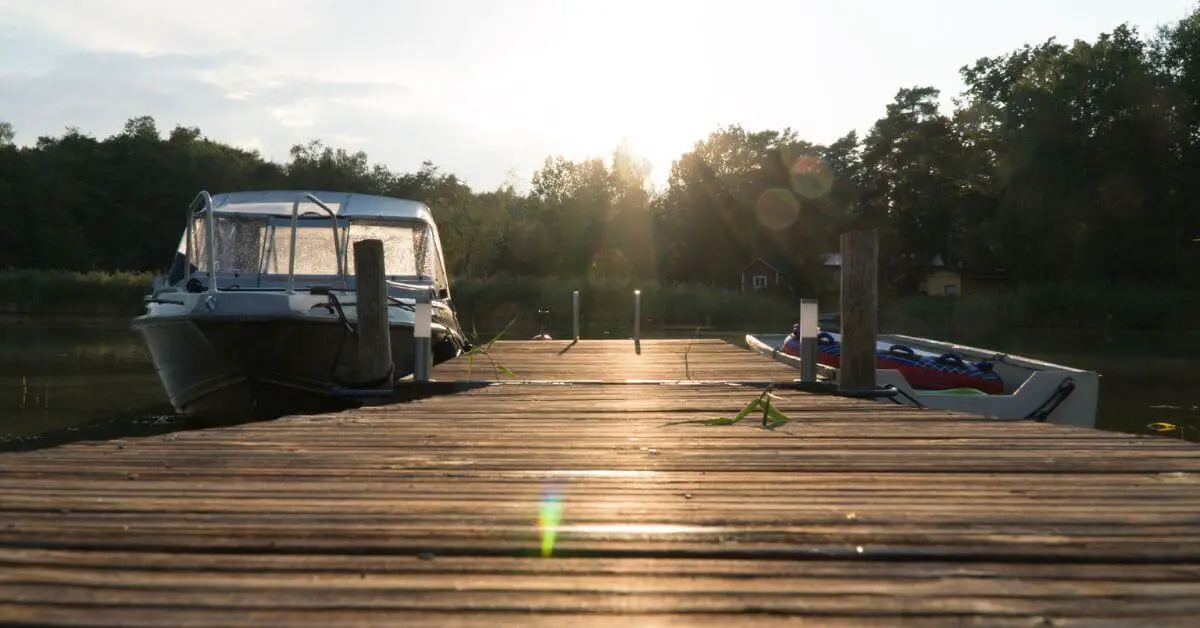If you’ve ever been sweating at the thought of docking your boat, fret no more. In this comprehensive guide, we’ll dive headfirst into the intricate world of docking, unraveling the secrets and techniques to help you execute a flawlessly smooth docking maneuver every time. So, grab your captain’s hat, and let’s set sail on this thrilling journey!
Understanding the Boat Docking Process
Docking a boat is an art that requires careful planning, precise execution, and a steady hand. It’s when you transition from an open-water adventure to securely mooring your vessel at the dock. But fret not; with the right approach and a little practice, you can become a docking maestro.
Boat docking involves various boat and dock parts to ensure a safe and efficient docking process. Here are some essential boat and dock parts that are commonly engaged in boat docking.
Cleats: Boat cleats are metal or plastic fittings typically found on a boat’s deck or sides. They are used to secure the boat’s ropes or lines, known as dock lines. Cleats have a distinctive shape, resembling a two-pronged fork or a T-shape, with one or more attachment points.
Fenders: Fenders are inflatable or foam-filled bumpers usually attached to the boat’s sides. They protect the hull from damage by absorbing the impact when the ship comes in contact with the dock.
Mooring Lines: Mooring lines are ropes or lines that connect the boat to the dock. They are used to secure the boat in place and prevent it from drifting or moving when docked.
Bow/Stern Thrusters: Bow and stern thrusters are additional propulsion systems that can be installed on a boat. They provide sideways movement, making it easier to maneuver the boat into position while docking, especially in tight spaces or difficult wind conditions.
Windlasses: Windlasses are mechanical devices used to raise and lower an anchor. They assist in anchoring the boat when docking in areas without a dock.
Dock Wheels: Some larger boats or docks may have dock wheels installed. These are usually located on the pier’s corners and help guide the boat during the docking process, ensuring a smooth entry.
Dock Cleats: Dock cleats are similar to boat cleats but are mounted on the dock. They provide attachment points for the boat’s mooring lines and are used to secure the boat to the dock.
Preparation: Setting the Stage for Docking Success
Before you approach the dock, take a moment to prepare and set yourself up for a successful docking experience. Here are some crucial steps to follow:
1. Plan Your Approach
Visualize your approach to the dock, taking into consideration factors such as wind, current, and neighboring boats. Consider the type of docking, whether bow-in, stern-in, or alongside. Plan the angle and speed at which you’ll approach the dock.
2. Assign Roles and Communicate
If you have crew members or a partner on board, assign roles to ensure a smooth docking process. Communicate their responsibilities, including line handling, fending off, and other crucial tasks.
3. Check Your Speed
Reduce your boat’s speed well before reaching the dock. Gradually slow down to a manageable pace, taking into account the size and weight of your vessel.
4. Ready the Lines
Make sure all lines are untangled, neatly coiled, and easily accessible. Position fenders along the sides of your boat for added protection during docking.
Executing the Perfect Docking Maneuver
Now that you’re ready to dock like a seasoned pro let’s walk through each step of the docking process in detail:
1. Approaching the Dock
As you move towards the dock, maintain a slow, controlled speed. Keep a vigilant eye on your surroundings, watching for any obstacles or other boats in the vicinity. Adjust your approach angle to counteract wind and current.
2. Utilize the Power of Shift and Throttle
Control your boat’s movement using a combination of shifting into neutral, using reverse, and adjusting the throttle. Experiment with these controls to understand how your boat responds, practice makes perfect!
3. Master the Art of Fender Placement
Place fenders between your boat and the dock to prevent any potential damage. Ensure they are positioned at the correct height and strategically placed along the boat’s side to provide maximum protection.
4. Communication is Key
Maintain clear and concise communication with your crew, or the person on the jetty side. Use hand signals or a predetermined docking language to convey instructions effectively. This teamwork ensures a smooth and coordinated docking process.
5. Use Your Boat’s Pivoting Point
Understand the pivotal point of your boat, which differs depending on the vessel’s design. Use this knowledge to your advantage when maneuvering close to the dock. Practice different turning angles to become familiar with your boat’s handling characteristics.
6. Mastering the Approach
Aim to approach the dock at a shallow angle, ensuring a controlled and gradual deceleration. Avoid coming in too quickly or at a steep slope, as this can make docking more challenging.
7. Steering and Reverse Propulsion
Use short bursts of propulsion to maneuver your boat’s bow or stern toward the dock. Remember, gentle adjustments are critical, small movements of the helm or tiller will help you maintain control and precision. Once your bow gets close to the dock, angle your wheel away from the dock and apply some reversing power to pull the back of the boat gently to the dock
8. Line Handling
As you approach the dock, assign crew members or any partner onboard the task of handling the lines. Coordinate their actions with your steering adjustments to gradually secure the boat to the dock.
Once you’ve finally reached the dock, it’s time to secure your vessel. Accomplish this by affixing your bow and stern lines to the pier. The type of knot you use will depend on the pier and where you’re fastening the lines.
9. Mastering Spring Lines
Utilize spring lines (long lines secured amidships) to control your boat’s position and prevent drifting. This technique is particularly useful when docking in strong winds or challenging currents.
10. Final Adjustment
Once you tie your boat securely, make any necessary adjustments to the lines and fenders. Please double-check that the boat is moored correctly and not rubbing against the dock or neighboring vessels.
How to Tie a Boat to a Dock
Tying a boat to a dock typically involves using dock lines or ropes to secure the boat. Here are some steps to follow when tying a boat to a dock:
1. Prepare the Dock Lines
Ensure you have adequate dock lines of appropriate length, material, and strength for your boat and the specific docking situation. Having at least three dock lines evenly spaced along the boat’s length is recommended.
2. Approach the Dock Slowly
Approach the dock slowly and carefully, aligning the boat parallel to the dock. The best practice when approaching the dock is to position the boat at roughly a 30-degree angle. Take it slow with your approach, as there’s a good chance you’ll at least lightly bump the dock.
Ideally, you want to stop with your prow just shy of the dock at a 30-degree angle. Take your time, slowly reduce the boat’s speed and momentum as you approach the desired docking position.
3. Attach the First Dock Line
As you approach the dock, have a crew member or someone on the dock ready to receive the dock line. Tie off your boat onto cleats, posts, or pilings using your docking lines. It’s often recommended to start with a midship line to establish control of the boat’s position.
4. Step Off the Boat
Once the first dock line is secured, step off the boat onto the dock, holding the remaining dock lines in hand. If you do not have enough personnel on the dock side, ensure you remain attentive to the boat’s movements.
5. Secure Additional Dock Lines
Use additional dock lines to secure the boat’s bow (front) and stern (rear) to the dock. Pass the lines through cleats on the boat, ensuring they are not twisted or tangled. Attach each line to a separate cleat on the dock, using appropriate knots such as cleat hitch or cleat knot.
6. Adjust the Tension
Adjust the tension of each dock line to ensure the boat is snug against the dock but not overly tight. Proper tension allows the boat to move with the dock’s fluctuations while remaining securely in place.
7. Double-Check Cleats and Lines
Double-check that all cleats and lines are properly secured and that there are no signs of wear or damage. Ensure the lines are neatly coiled and out of the way to avoid tripping hazards.
Practicing Docking your Boat: Tips and Tricks to Enhance Your Skills
Docking is an acquired skill that improves with practice. Here are a few tips to refine your docking prowess:
1. Experiment in Different Conditions: Practice docking in various weather conditions, such as calm waters, high winds, or strong currents. This exposure will build both your confidence and adaptability.
2. Repetition is Key: Docking techniques become second nature through repetition. Take every opportunity to practice, refining your skills with each attempt.
3. Seek Professional Training: Consider taking a boating course or seeking guidance from an experienced boater. Expert instruction and feedback can significantly accelerate your learning curve and provide valuable insights.
4. Learn from Others: Observe experienced boaters docking their vessels. Note their techniques, approaches, and the strategies they employ. Learning from those with more experience can be invaluable.
5. Maintain a Positive Mindset: Don’t be discouraged by a few initial failed attempts. Stay patient and positive, and learn from each docking experience. Remember, even the most seasoned boaters encounter challenges from time to time.
Related Article: How to Drive a Boat: A Step-by-Step Guide
Safety First: How to Dock a Boat with Caution
While docking may be an adrenaline-filled adventure, safety should always be paramount. Here are some crucial safety considerations to keep in mind:
1. Protect Yourself: Wear appropriate safety gear, including life jackets and non-slip footwear, during the docking process. Accidents can happen, so always prioritize your safety.
2. Secure Loose Items: Secure any loose or movable items on deck to prevent them from becoming hazards during the docking maneuver.
3. Double-Check All Lines: Regularly inspect your lines for wear and tear, ensuring they are in good condition and securely fastened. Replace any worn-out lines promptly.
4. Be Mindful of Electricity: If your boat is equipped with electrical connections at the dock, exercise caution to avoid electric shocks or malfunctioning equipment. Always follow proper electrical safety protocols.
5. Be Aware of Your Surroundings: Watch people, other boats, and potential obstacles during the docking process. Minimize distractions and maintain vigilance to prevent accidents.
Conclusion
With the knowledge, skills, and techniques outlined in this guide, you’re ready to dock your boat like a seasoned pro. Remember, docking is not just about precision, it’s an opportunity to showcase your skills and enjoy the satisfaction of flawlessly managing your boat in tight quarters.
Practice, preparation, and continuous learning will refine your docking abilities over time. So, cast your anxieties aside, embrace the challenges, and approach each docking experience with enthusiasm.
With a bit of practice and a dash of courage, you’ll soon be docking like a true captain, impressing onlookers and making every docking maneuver a seamless work of art.
Reference









